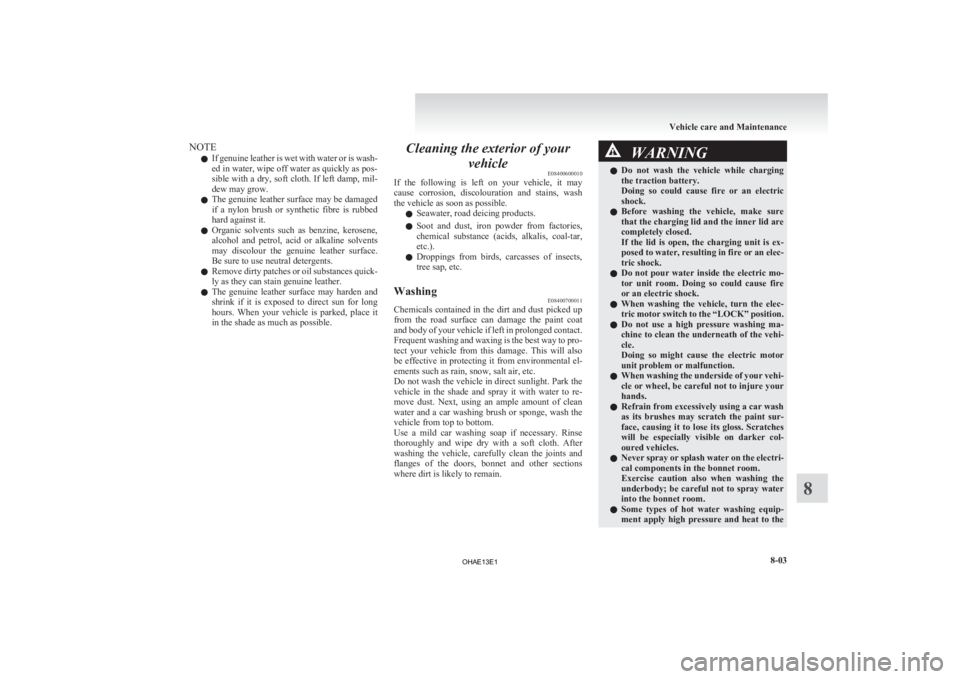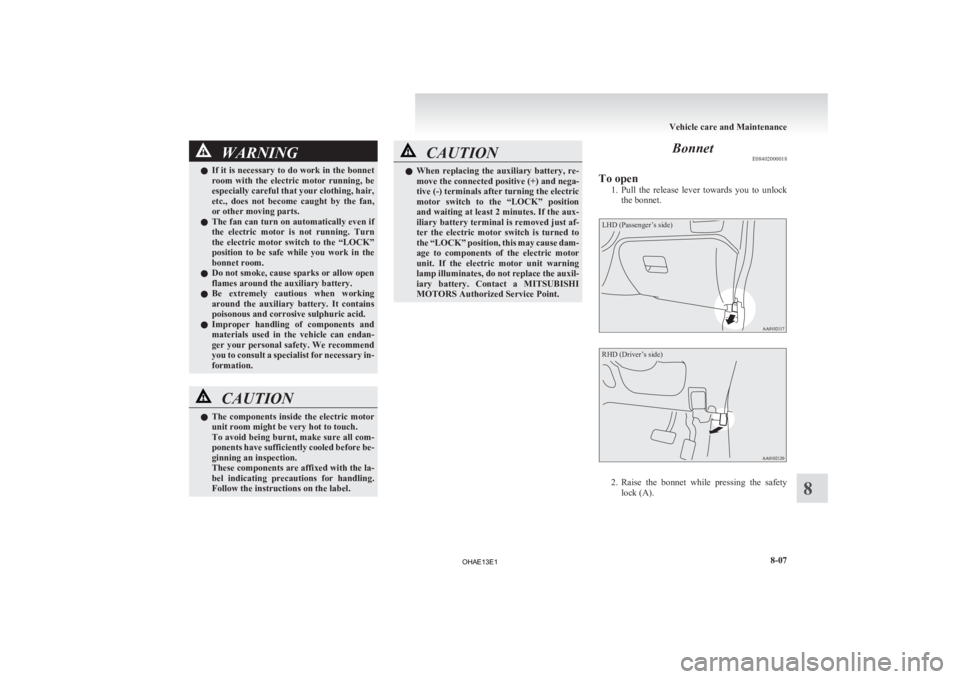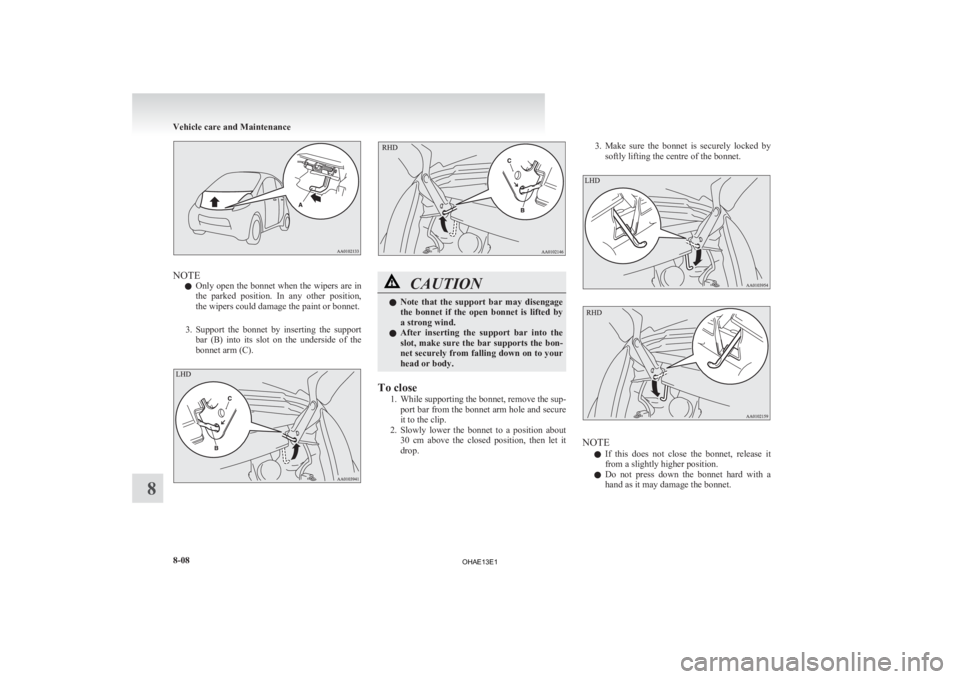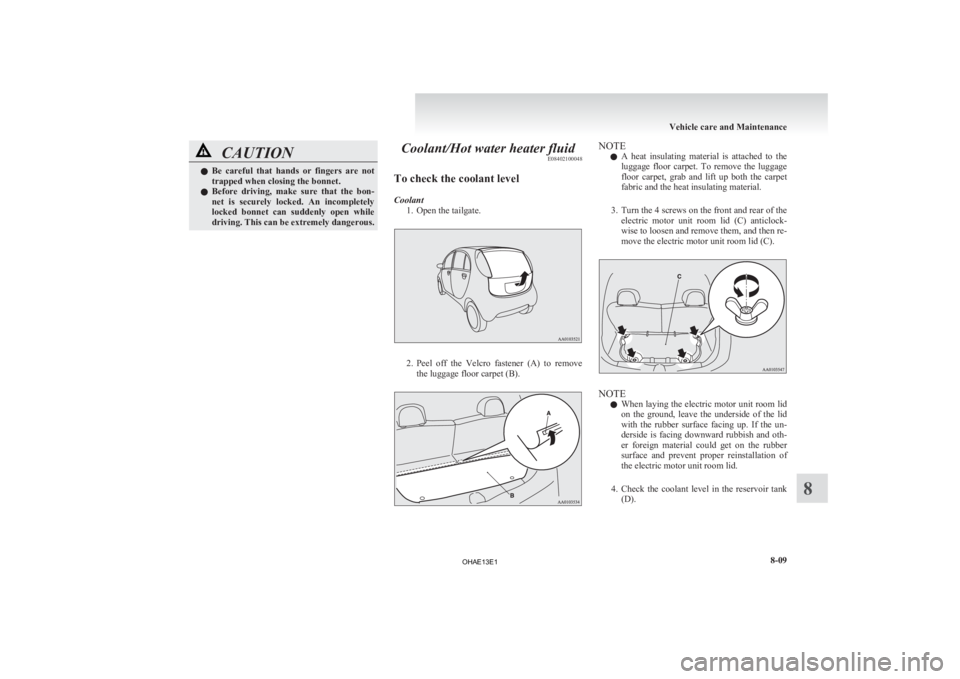2013 MITSUBISHI iMiEV open bonnet
[x] Cancel search: open bonnetPage 6 of 258

Instruments and Controls (Instrument panel)
E001001064121. Centre ventilators p. 6-10
2.
Digital clock* p. 6-31Audio* p. 6-10
3. Hazard warning flasher switch p. 4-15
4. Supplemental restraint system - airbag (for front passen- ger) p. 3-20
5. Side ventilators p. 6-02
6. Cup holder p. 6-40
7. Glove box p. 6-39
8. Bonnet release lever p. 8-07
9. Front passenger’s airbag ON-OFF switch p. 3-23
10. Card holder p. 6-39
11. Rear window demister switch p. 4-18
12. Accessory socket p. 6-36
13. Parking brake lever p. 5-03
14. Cup holder p. 6-40
15. Selector lever p. 5-09
16. Heated seat switch p. 3-04
17. Quick charging lid opener p. 1-12
18. USB input terminal* p. 6-33
19. Air conditioning p. 6-03
20. Heated seat switch p. 3-04 OverviewLHD
OHAE13E1
Page 7 of 258

1. Secret box p. 6-39
2.
Supplemental restraint system - airbag (for front passen-ger) p. 3-20
3. Digital clock* p. 6-31 Audio* p. 6-10
4. Hazard warning flasher switch p. 4-15
5. Air conditioning p. 6-03
6. Centre ventilators p. 6-10
7. Heated seat switch p. 3-04
8. Bonnet release lever p. 8-07
9. Acoustic Vehicle Alerting System (AVAS) OFF switch p. 5-13
10. Quick charging lid opener p. 1-12
11. Front passenger’s airbag ON-OFF switch p. 3-23
12. Heated seat switch p. 3-04
13. Selector lever p. 5-09
14. Parking brake lever p. 5-03
15. Cup holder p. 6-40
16. Accessory socket p. 6-36
17. USB input terminal* p. 6-33
18. Card holder p. 6-39
19. Glove box p. 6-39
20. Cup holder p. 6-40
21. Side ventilators p. 6-02 OverviewRHD
OHAE13E1
Page 30 of 258

Regular charging (charging
method with rated AC 220-240 V outlet) E08300900054WARNING
l For safety, do not allow children or peo-
ple who are not familiar with charging to
charge for themselves. Also, do not use
the charge connector within reach of chil-
dren.
l Persons who use electro-medical appara-
tus such as implantable cardiac pacemak-
er or implantable cardioverter defibrilla-
tor must check effect from charging with
the manufacturer of electro-medical appa-
ratus.
l If you use any medical electric devices,
take into account the following precau-
tions.
• Do not stay inside the vehicle.
• Do not go inside the vehicle, for exam-ple to remove or place an item in the
passenger compartment.
• Do not open the rear hatch, for exam- ple to remove or place an item in the
cargo area.
Charging may affect the operation of elec-
tric medical devices and result in serious
personal injury or death.
l Do not charge with the EV charging ca-
ble banded or rolled.
Doing so the cable may be heated and this
might result in fire. WARNING
l Before
charging, make sure that there is
no foreign matter such as dust at the reg-
ular charge port and the regular charge
connector.
At this time, do not touch the regular
charge port.
l When the regular charge connector is con-
nected to the charge port, prevent foreign
matter such as water or dust from enter-
ing in the port.
Connection with foreign matter such as
water or dust may cause fire or an elec-
tric shock. Do not perform charging if
there might be strong exposure to water
at the connection.
l Never pull the cable to remove the plug.
And never submerge the EV charging con-
nector, control box or plug in water.
l Please observe the following in order to
prevent accidents during charging such
as electrocution.
• Always use a charging cable that suit-able for this vehicle.
• Do not charge another vehicle using the attached EV charging cable.
Doing so the cable may be heated and
this might result in fire.
• Make sure to use an outlet that is pro- tected from water entering.
• Do not perform charging with the body cover.
• Do not remove and insert the plug and connector with wet hands.
• Do not charge the battery if there is a risk of lightning. WARNING
l While it is normal for the connector and
charging cable to become warm during
charging, discontinue use immediately if
the connector or charging cable becomes
hot to the touch.
l While it is normal for the control box to
become warm during charging, discontin-
ue use immediately if the control box be-
comes hot to the touch.
l If abnormal smells are detected or the ve-
hicle produces smoke, quickly stop charg-
ing.
l Do not perform charging at a poorly ven-
tilated place with surroundings covered.
Keep sparks, cigarettes, and flames away
from the auxiliary battery.
Flammable gas generated from the auxili-
ary battery in charging may be filled in a
building, resulting in explosion.
If charging is inevitably required, venti-
late the area well.
l Grasp the regular charge connector when
connecting or disconnecting the EV charg-
ing cable.
Grasping the cable could cause an elec-
tric shock, short circuit, and/or fire.
l During charging, the cooling fans inside
the bonnet room may automatically be op-
erated even if the electric motor switch is
in the “LOCK” position.
Keep your hands away from the cooling
fan during charging. Charging
1-08
1
OHAE13E1
Page 35 of 258

WARNING
l When the quick charge connector is con-
nected to the quick charge port, prevent
foreign matter such as water or dust
from entering in the port.
Connection with foreign matter such as
water or dust may cause fire or an elec-
tric shock. Do not perform charging if
there might be strong exposure to water
at the connection.
l During charging, the cooling fans inside
the bonnet room may automatically be op-
erated even if the electric motor switch is
in the “LOCK” position.
Keep your hands away from the cooling
fan during charging.
NOTE l If
the charge connector is not easily connec-
ted to the charge port due to foreign material
entering, never force the connection. Doing
so could damage the charging equipment or
the vehicle. Contact a MITSUBISHI
MOTORS Authorized Service Point.
l The quick charger might be installed in the
public parking space, some chargers are not
suitable for this vehicle. Check the manual of
each quick charger when charging.
l The charge connector and the EV charging ca-
ble stick out of the vehicle body while charg-
ing, so be careful that your body does not get
stuck with them or they do not touch the next
vehicle. l
The
vehicle equipped with a quick charge
port is compatible with most CHAdeMO (Jap-
anese industry standard) connectors on charg-
ing stations.
l Make sure to lock the doors to prevent theft,
etc. during charging.
1. Fully apply the parking brake and move the selector lever to the “P” (PARK) position.
2. Stop the electric devices such as lamps, air conditioning, etc. and turn the electric motor
switch to the “LOCK” position.
3. Pull the quick charging lid opener (A) at the bottom left/right of the driver’s seat to open
the quick charging lid (B) at the left rear side
of the vehicle. 4. Press the tab (C) to open the inner lid (D). WARNING
l Do
not touch the metal terminal of the
quick charge port (E) and the quick
charge connector.
Doing so could cause an electric shock and/
or malfunction. CAUTION
l
Be sure to insert the quick charge connec-
tor
straight into the quick charge port
right up to the base.
Failure to do so may result in the traction
battery not charging or could cause dam-
age to the charging equipment.
l Do not leave for a long time with the in-
ner lid opened. It becomes impossible to
charge if a foreign material is entered to
the quick charge port. Charging
1-13 1
OHAE13E1
Page 201 of 258

NOTE
l If
genuine leather is wet with water or is wash-
ed in water, wipe off water as quickly as pos-
sible with a dry, soft cloth. If left damp, mil-
dew may grow.
l The genuine leather surface may be damaged
if a nylon brush or synthetic fibre is rubbed
hard against it.
l Organic solvents such as benzine, kerosene,
alcohol and petrol, acid or alkaline solvents
may discolour the genuine leather surface.
Be sure to use neutral detergents.
l Remove dirty patches or oil substances quick-
ly as they can stain genuine leather.
l The genuine leather surface may harden and
shrink if it is exposed to direct sun for long
hours. When your vehicle is parked, place it
in the shade as much as possible. Cleaning the exterior of your
vehicle E08400600010
If
the following is left on your vehicle, it may
cause corrosion, discolouration and stains, wash
the vehicle as soon as possible.
l Seawater, road deicing products.
l Soot and dust, iron powder from factories,
chemical substance (acids, alkalis, coal-tar,
etc.).
l Droppings from birds, carcasses of insects,
tree sap, etc.
Washing E08400700011
Chemicals contained in the dirt and dust picked up
from
the road surface can damage the paint coat
and body of your vehicle if left in prolonged contact.
Frequent washing and waxing is the best way to pro-
tect your vehicle from this damage. This will also
be effective in protecting it from environmental el-
ements such as rain, snow, salt air, etc.
Do not wash the vehicle in direct sunlight. Park the
vehicle in the shade and spray it with water to re-
move dust. Next, using an ample amount of clean
water and a car washing brush or sponge, wash the
vehicle from top to bottom.
Use a mild car washing soap if necessary. Rinse
thoroughly and wipe dry with a soft cloth. After
washing the vehicle, carefully clean the joints and
flanges of the doors, bonnet and other sections
where dirt is likely to remain. WARNING
l Do
not wash the vehicle while charging
the traction battery.
Doing so could cause fire or an electric
shock.
l Before washing the vehicle, make sure
that the charging lid and the inner lid are
completely closed.
If the lid is open, the charging unit is ex-
posed to water, resulting in fire or an elec-
tric shock.
l Do not pour water inside the electric mo-
tor unit room. Doing so could cause fire
or an electric shock.
l When washing the vehicle, turn the elec-
tric motor switch to the “LOCK” position.
l Do not use a high pressure washing ma-
chine to clean the underneath of the vehi-
cle.
Doing so might cause the electric motor
unit problem or malfunction.
l When washing the underside of your vehi-
cle or wheel, be careful not to injure your
hands.
l Refrain from excessively using a car wash
as its brushes may scratch the paint sur-
face, causing it to lose its gloss. Scratches
will be especially visible on darker col-
oured vehicles.
l Never spray or splash water on the electri-
cal components in the bonnet room.
Exercise caution also when washing the
underbody; be careful not to spray water
into the bonnet room.
l Some types of hot water washing equip-
ment apply high pressure and heat to the Vehicle care and Maintenance
8-03 8
OHAE13E1
Page 205 of 258

WARNING
l If it is necessary to do work in the bonnet
room with the electric motor running, be
especially careful that your clothing, hair,
etc., does not become caught by the fan,
or other moving parts.
l The fan can turn on automatically even if
the electric motor is not running. Turn
the electric motor switch to the “LOCK”
position to be safe while you work in the
bonnet room.
l Do not smoke, cause sparks or allow open
flames around the auxiliary battery.
l Be extremely cautious when working
around the auxiliary battery. It contains
poisonous and corrosive sulphuric acid.
l Improper handling of components and
materials used in the vehicle can endan-
ger your personal safety. We recommend
you to consult a specialist for necessary in-
formation. CAUTION
l
The
components inside the electric motor
unit room might be very hot to touch.
To avoid being burnt, make sure all com-
ponents have sufficiently cooled before be-
ginning an inspection.
These components are affixed with the la-
bel indicating precautions for handling.
Follow the instructions on the label. CAUTION
l
When
replacing the auxiliary battery, re-
move the connected positive (+) and nega-
tive (-) terminals after turning the electric
motor switch to the “LOCK” position
and waiting at least 2 minutes. If the aux-
iliary battery terminal is removed just af-
ter the electric motor switch is turned to
the “LOCK” position, this may cause dam-
age to components of the electric motor
unit. If the electric motor unit warning
lamp illuminates, do not replace the auxil-
iary battery. Contact a MITSUBISHI
MOTORS Authorized Service Point. Bonnet
E08402000018
To open 1. Pull
the release lever towards you to unlock
the bonnet.
LHD (Passenger’s side)
RHD (Driver’s side) 2. Raise
the bonnet while pressing the safety
lock (A). Vehicle care and Maintenance
8-07 8
OHAE13E1
Page 206 of 258

NOTE
l Only
open the bonnet when the wipers are in
the parked position. In any other position,
the wipers could damage the paint or bonnet.
3. Support the bonnet by inserting the support bar (B) into its slot on the underside of the
bonnet arm (C). CAUTION
l
Note
that the support bar may disengage
the bonnet if the open bonnet is lifted by
a strong wind.
l After inserting the support bar into the
slot, make sure the bar supports the bon-
net securely from falling down on to your
head or body.
To close 1. While
supporting the bonnet, remove the sup-
port bar from the bonnet arm hole and secure
it to the clip.
2. Slowly lower the bonnet to a position about 30 cm above the closed position, then let it
drop. 3. Make
sure the bonnet is securely locked by
softly lifting the centre of the bonnet. NOTE
l If
this does not close the bonnet, release it
from a slightly higher position.
l Do not press down the bonnet hard with a
hand as it may damage the bonnet. Vehicle care and Maintenance
8-08
8
OHAE13E1
Page 207 of 258

CAUTION
l
Be careful that hands or fingers are not
trapped when closing the bonnet.
l Before driving, make sure that the bon-
net is securely locked. An incompletely
locked bonnet can suddenly open while
driving. This can be extremely dangerous. Coolant/Hot water heater fluid
E08402100048
To check the coolant level
Coolant 1.
Open the tailgate. 2. Peel
off the Velcro fastener (A) to remove
the luggage floor carpet (B). NOTE
l A
heat insulating material is attached to the
luggage floor carpet. To remove the luggage
floor carpet, grab and lift up both the carpet
fabric and the heat insulating material.
3. Turn the 4 screws on the front and rear of the electric motor unit room lid (C) anticlock-
wise to loosen and remove them, and then re-
move the electric motor unit room lid (C). NOTE
l When
laying the electric motor unit room lid
on the ground, leave the underside of the lid
with the rubber surface facing up. If the un-
derside is facing downward rubbish and oth-
er foreign material could get on the rubber
surface and prevent proper reinstallation of
the electric motor unit room lid.
4. Check the coolant level in the reservoir tank (D). Vehicle care and Maintenance
8-09 8
OHAE13E1